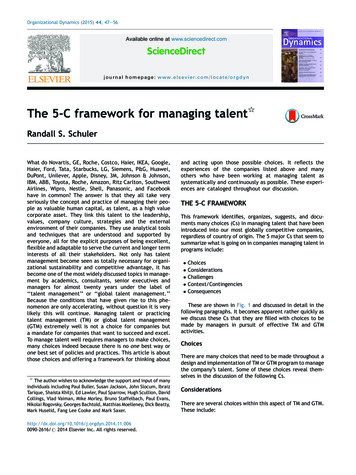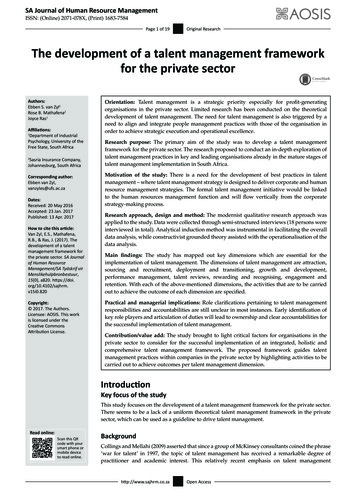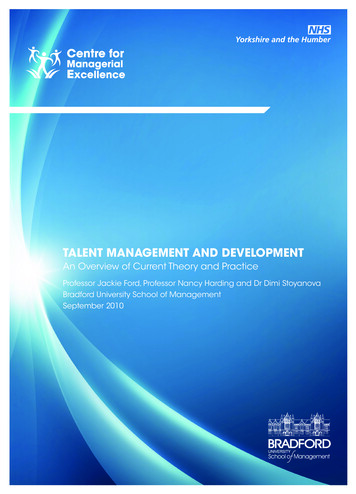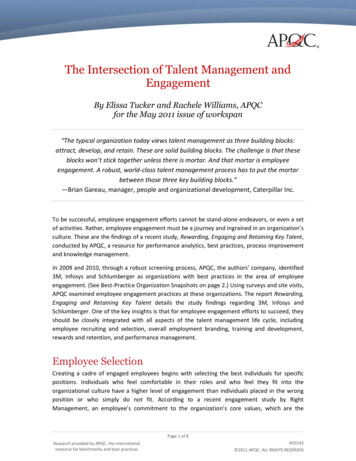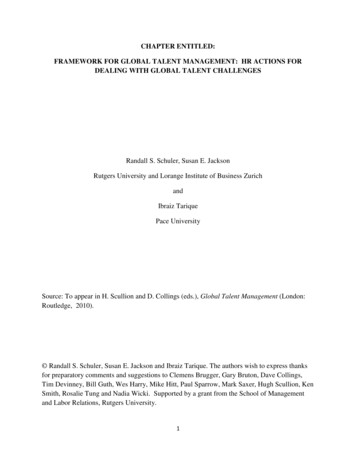
Transcription
CHAPTER ENTITLED:FRAMEWORK FOR GLOBAL TALENT MANAGEMENT: HR ACTIONS FORDEALING WITH GLOBAL TALENT CHALLENGESRandall S. Schuler, Susan E. JacksonRutgers University and Lorange Institute of Business ZurichandIbraiz TariquePace UniversitySource: To appear in H. Scullion and D. Collings (eds.), Global Talent Management (London:Routledge, 2010). Randall S. Schuler, Susan E. Jackson and Ibraiz Tarique. The authors wish to express thanksfor preparatory comments and suggestions to Clemens Brugger, Gary Bruton, Dave Collings,Tim Devinney, Bill Guth, Wes Harry, Mike Hitt, Paul Sparrow, Mark Saxer, Hugh Scullion, KenSmith, Rosalie Tung and Nadia Wicki. Supported by a grant from the School of Managementand Labor Relations, Rutgers University.1
FRAMEWORK FOR GLOBAL TALENT MANAGEMENT: HR ACTIONS FORDEALING WITH GLOBAL TALENT CHALLENGESIntroductionUp until 2008 firms around the world were confronted with a major threat to doing business: ademand for talented employees that far surpassed the supply. This was especially acute in thedeveloping countries that were benefiting from a strong business cycle based upon tremendousexports to the developed nations, and increased foreign direct investment from firms indeveloped nations wishing to take advantage of substantially lower wages in developingcountries. Forecasts were being made of even greater shortages to come due to forecasts forcontinued global economic growth virtually everywhere, but especially in the developingnations. Firms worked aggressively to retain their current employees, often providing trainingand development benefits to make the firm more attractive, and also to develop the talents ofthese workers. “Talent” became a key word in global business. Firms faced many global talentchallenges including having the right number of competent employees at the right place and atthe right time.They also faced the challenge of needing to reduce the costs of operations, thus movingoperations abroad, paying lower wages and then having to find competent employees to staff thefacility. All of these challenges were dealt with through “global talent management” initiatives.These were composed of various HR actions depending upon the nature of the global talentchallenge. This chapter describes these global talent management initiatives. Some of ourdiscussion reflects conditions that were present during recent economic and financial boom times(i.e., the two decades prior to 2008), when worker shortages were a primary concern. Economicexpansion is likely to return eventually, so labor shortages are of continuing concern.Nevertheless, in the near term, this concern may subside somewhat. Regardless of the size of thegap between the available and desired pool of talent globally, a variety of other concerns remainas major global talent challenges.We begin this chapter by defining more specifically what we mean by global talent challengesand global talent management. Next, we describe in some detail the major drivers of the globaltalent challenges facing modern multinational firms. Having set the stage by describing thebroader context, we then turn to a discussion of specific HR actions that comprise a domain ofactivity that often is now referred to as “global talent management.” Finally, after acknowledgingsome of the barriers that can make achieving effective global talent management difficult, weconclude with a brief summary of the potential results of effective global talent management, forit is these desired results that motivate multinational firms to continuously improve theirapproaches to global talent management.2
Global Talent Challenges and Global Talent ManagementIn today’s rapidly moving, extremely uncertain, and highly competitive global environment,firms worldwide are encountering numerous global talent challenges. Global talent challengesarise as firms compete on a worldwide stage under dynamic conditions to ensure that they havethe necessary amount of talent, at the appropriate places, at the right prices and times. Firms thatsuccessfully address these challenges are able to secure and/or create a workforce that meets thetalent needs of the firm in the short term while positioning the firm to also meet their longer termtalent needs. We assume that effective global talent management requires employers to beresponsive to the concerns of a global workforce and work with them as partners to achievebusiness objectives. [For a more complete discussion of this partnership perspective, seeJackson, Schuler, and Werner, 2009.]To successfully address global talent challenges, firms of all sizes can and must take advantageof a wide variety of human resource management (HR) actions, which include the developmentof human resource policies and the design and implementation of specific HR practices (seeJackson et al., 2009). Conceptualized broadly, global talent management refers to the use of HRactions to ensure access to needed talent by multinational enterprises competing in a globalenvironment; it includes HR policies and practices related to planning and forecasting, obtaining,selecting, motivating, developing, evaluating, retaining, and removing employees consistentwith a firm’s strategic directions while taking into account the evolving concerns of theworkforce and regulatory requirements.Major Drivers of the Global Talent ChallengesGlobal talent management is carried out in the context of a dynamic environment. Among themany factors that shape the specific challenges and responses of particular firms are severalmajor drivers, which include: (a) globalization, (b) changing demographics, (c) demand forworkers with needed competencies and motivation, and (d) the supply of those neededcompetencies and motivation. Figure 1 depicts the linkage between these drivers and several HRactions used to management global talent. We describe these drivers in more detail in thefollowing paragraphs.Insert Figure 1 about hereGlobalization: World Trade, Competition, Customers, IndividualsGlobalization is a concept that people use when referring to many different phenomena. Ofparticular relevance to our discussion are: expansion of world trade, intensified competition3
among firms, the potential to reach many more customers around the world, and the array ofindividuals worldwide who now comprise a global labor market.World Trade. The value of world trade expanded from 89 billion in 1953 to more than 10trillion in 2008. Although the contraction that occurred in 2009 may slow the rate of futureexpansion in the near term, the value of world trade may nevertheless reach 27 trillion by 2030.Foreign direct investment (FDI) went from 59 billion in 1982 to more than 1 trillion in 2008.The formal labor market expanded from 2 billion workers in 1990 to more than 3.5 billion in2008. The global economy is projected to expand to 75 trillion by 2030, up from 10 trillion in1970 and 40 trillion in 2008 ( Kearney, 2008; Stephenson and Pandit, 2008). While forecasts ofspecific values such are only best estimates, most observers agree that the long-term trend is forcontinued expansion of world trade in the longer term. Thus, while forecasts made early in 2009pointed to a significant slowdown in FDI and world GDP that year (The Economist, February 21,2009), by the end of the same year, forecasts for 2010 were projecting a modest upturn globally.Competition. Competition has never been this intense and so multifaceted: it is fast developing,complex, extremely widespread, but also subject to the current global economic and financialcrises (The Economist, February 21, 2009; Zakaria, 2008; Cairns and Sliwa, 2008; IBM, 2008;Hill, 2007). Global competition has forced many firms to improve quality and strive forinnovation (often based on rapidly developed and more sophisticated technology), andincreasingly global competition means that enhanced quality and innovation must be achievedwhile also keeping cost low. Thus, small and larger firms in almost every country are beingforced to adapt and quickly respond as they compete with firms worldwide to gain and sustainglobal competitive advantage (The Economist, March 14, 2009; Engardio and Weintraub, 2008;Porter, 1985; IBM, 2008; Stephenson and Pandit, 2008; Palmisano, 2007; Schuler and Tarique,2007; Gupta and Govindarajan, 2001). Globalization requires multinational companies to seekeconomies of scale and scope, find and take advantage of optimal locations while anticipatingfuture relocations, adapt to local differences, learn continuously, and transfer knowledge moreeffectively than their competitors (Ghemawat and Hout, 2007; Porter, 1985; Krugman, 1979;1981; Gupta and Govindarajan, 2001). A global competitive advantage awaits those firms thatsucceed in meeting these challenges (Daniels, Radebaugh and Sullivan, 2007).Customers. Customers in virtually all industries are demanding more, and often for less. Thetelecom industry is migrating rapidly from traditional fixed-line phone service to mobile, smartphones. Companies like BT are selling “experiences” more than telephone “hardware.”Customers are demanding innovation and BT is responding by focusing on services andproviding a social networking capability (Werdigier, 2008). And this applies to customers theworld over, with some differences reflecting unique characteristics of the countries (Zakaria,2008). Thus for the typical company today, it is important to think and act global (IBM, 2008;Mendenhall, Osland, Bird, Oddou and Maznevski, 2008; Dickmann and Baruch, 2010), whichincludes being where the customers are. Increasingly companies like Nokia, IBM, Tata,Caterpillar, and BT find that the growing customer base is in the BRIC countries (Brazil, Russia,4
India, and China) and in emerging economies throughout Asia, Latin America, and EasternEurope.Individuals. Individuals have been entering into the labor market in increased numbers over thepast fifteen years (Zakaria, 2008; Friedman, 2005). It has been estimated that more than 1.5billion people have entered the global formal labor market during the past fifteen years.Friedman (2005) argued that the development and spread of inexpensive technologies hasflattened the world and facilitated the entry of all these workers into the workforce. One majorconsequence is the ability of firms to employ workers in the developing economies of the worldat much lower wages than is possible in the developed economies of the world. Weekly wagesin the developed economies are equivalent to monthly and even yearly wages in developingeconomies (U.S. Department of Labor, 2008; Gomez-Mejia and Werner, 2008). The movementof work to an array of dispersed locations that may include both developed and developingeconomies is most likely to succeed\ when all employees have the needed the competencies andmotivations to do the work, when the work of dispersed employees is effectively coordinated,and when a firm’s HR actions are consistent with the full array of relevant employmentregulations in every location (Porter, 1985; Hill, 2007; World Bank, 2008; Palmisano, 2007). Inaddition to meeting these challenges, as multinational firms make decisions about workforcelocation and relocation, they also must address the challenges of developing an appropriatecustomer base, identifying and outmaneuvering competitors, managing transportation costs,reducing the possible consequences of political instability, protecting their intellectual property,and rights and so on (Porter, 1985;Daniels, et al., 2007; World Bank, 2008; Palmisano, 2007).DemographicsWorldwide demographics are another major driver of global talent management. In NorthAmerica, Western Europe, Japan and Australia, the age of retirement is being ushered in by theBaby Boomer generation. While this may be a relatively short term phenomenon in NorthAmerica (due to current birth and immigration rates), population shrinkage is a longer term eventin Western Europe and Japan (Strack, Baier and Fahlander, 2008). The long term-term outlookis grim: by 2025 the number of people aged 15-64 is projected to fall by 7% in Germany, 9% inItaly and 14% in Japan (Wooldridge, 2007; The Economist, 2006).“If you take into consideration the 70 million Baby Boomers expected to retire over the next 15years (in the U.S.) and only 40 million workers expected to enter the workforce in the sameperiod, you can plainly see that a shortage of workers is imminent” (Adecco, 2008:9). “By 2010,it is expected the U.S. will face a shortage of more than 10 million workers” (Adecco, 2008:10).And according to Stephen Hitch, a human resource manager at Caterpillar in Peoria, Illinois:“We’ve got a global problem and it’s only going to continue to get worse” (Coy and Ewing,2007:28). Of course, these pre-2008 projections are now being adjusted somewhat with morebaby boomers extending their retirement dates due to significant depletions of their retirementsavings as a consequence of the current economic and financial crises (Hansen, 2009a).5
While the populations of many developed economies are aging and shrinking in size, thepopulations of developing and emerging economies are expanding and getting younger (Strack,et al., 2008). Thus there are major variations in demographic characteristics by age and byregion that multinational firms need to know and consider in locating and relocating theiroperations internationally.Demand for Workers with Competencies and MotivationAlthough the pace of globalization has diminished greatly, new jobs are still being created thatrequire higher levels of competencies, which are broadly defined as “basic and advanced skills,knowledge and abilities,” or the “right know-how” (Daniels, et al., 2007; Palmisano, 2007. Forexisting jobs, there is a growing need for employees who are willing to do the job under new andchanging conditions that require the development of additional competencies (motivation). Forskilled jobs, for example, there is a need for increased competencies to operate moresophisticated machinery, to interact with more demanding customers and to use more advancedtechnology to perform the functions of the traditional skilled jobs (National Commission onAdult Literacy, 2008). And it appears that these increased competencies are being associatedwith almost all jobs traditionally performed in multinational firms around the world today (Priceand Turnbull, 2007).In addition to the increased need for basic skills and advanced skill levels for basic entry-level,frontline and skilled jobs, there are a rising number of jobs that involve “knowledge work” andthus there is increasing demand for so-called “knowledge workers.” This is true around theworld, be it in China, India, Europe or North America. By one estimate, 48 million of the 137million workers in the U.S. alone can be classified as knowledge workers. Knowledge workoften requires competencies that are developed through extensive education and training and it isgenerally work that is capable of having a significant impact on the success of the company(Jackson, Hitt, and DeNisi, 2003). Knowledge workers include managers, leaders, technicians,researchers, accountants, information specialists, consultants, medical and pharmaceuticalprofessionals. In multinational firms, knowledge workers such as these often work together inteams that cross cultural and geographic borders: “In the 21st century knowledge creation,integration and the leveraging of such “new” knowledge are considered the raison d’etre ofmultinational firms” (Brannen, 2008). “The growing need for talented managers in Chinarepresents by far the biggest management challenge facing multinationals and locally ownedbusinesses alike” (Lane and Pollner, 2008). Even if demand for managers and other knowledgeworkers has slowed significantly recently, the need for highly motivated and talented knowledgeworkers is likely to remain strong well into the future (Roach, 2009).Just before the economic and financial crises began in 2008, the most prevalent question was:“Where are all the workers? “ Although this is not the prevalent question today, it is likely toreturn sooner than later: “Whether you can hear it or not, a time bomb is ticking in C-suitesworldwide. Its shock waves will resonate for decades. Surveys conducted by the firm I work for6
(Egon Zehnder International) indicate that the number of managers in the right age bracket forleadership roles will drop by 30% in just six years. Factor in even modest growth rates, and theaverage corporation will be left with half the critical talent it needs by 2015” (Fernández-Aráoz,2009: 72).Just as the global economy began to slow in 2008, a study conducted by the global staffingagency Manpower, found that nearly 40% of 37,000 companies across twenty-seven countrieswere finding it a challenge to hire the people they needed (Manpower, 2008a). In a 2007 surveyof more than 1,300 senior managers around the world found that the most significant trendexpected to affect their business over the next five years was greater competition for talentworldwide (Price and Turnbull, 2007). More specifically, CEOs are searching for industry,technical and particularly management skills to support geographic expansion: Many CEOsconsider insufficient talent to be a significant barrier to global integration, surpassing theimportance of regulatory and budgetary hurdles (IBM, 2008). In other words, most companiesworldwide, regardless of size, are confronting and/or will soon confront their global talentchallenge of talent shortage that if ignored will impact their global business strategies (Dunning,2000; Manpower, 2008b).This global talent challenge appears to be a concern across many countries/companies, andespecially in India, China and Brazil: According to a recent survey in China “88% of the Chineseexecutives said their globalization efforts were hindered by the scarcity of people with real crosscultural knowledge or experience managing foreign talent; ninety-three percent said that Chinesecompanies would not achieve their global aspirations unless they developed suitable leadersmore aggressively”(Dietz, Orr and Xing, 2008). For entry-level corporate positions, there seemsto be a mismatch between the skills found among graduates many Chinese universities and theytypes of skills that are needed by local, regional and multinational companies (Lane and Pollner,2008).The most frequently cited reasons for candidates being under-qualified include: poor Englishskills (which are needed to conduct international business), lack of experience working in teams,and a reluctance to assume leadership roles (McKinsey, 2008). So while the graduation numbersof countries like India, China and Brazil are very impressive, those who are qualified to beginworking in many companies are significantly less. For example, in India, the percentage ofengineering graduates deemed qualified enough to hire is estimated to be 25%; in China theestimated portion is 10%; and in Brazil it is 13% (McKinsey, 2008). McKinsey predicted, thatIndia would face a shortage of 500,000 staff capable of doing work for multinationals (Engardio,2007). Clearly, the skills gap is threatening the technology boom in India (Sengupta, 2006).According to Jose Sergio Gabrielli, President of Petrobras, the state-run oil company in Brazil,“The lack of availability of technical ability may be a constraint on growth, no doubt about it”(Downie, 2008: C1,5). The supply situation in other major countries around the world is largelythe same as in India, China and Brazil.7
Supply of Workers with Competencies and MotivationIn developed economies such as North America, Western Europe and Japan there also is anexpected shortage of competencies. According to a report from the U.S. National Commissionon Adult Literacy (2008) between 80 and 90 million American adults do not have the basiccommunication (also called people or “soft”) skills to function well in the global economy or toearn family-sustaining wages. Alone among other advanced industrial countries, American 25 to35 year olds are not as well educated as their parents. This same reality is also being found inArab nations where the younger generation sees that connections rather than education are oftenthe route to career success (Harry, 2007). According to the U.S. National Commission on AdultLiteracy, declining educational achievement now puts the U.S. at a competitive disadvantage(2008). The lack of technical knowledge workers continues to drive companies such asMicrosoft, Cisco and Wipro to plead with the U.S. Congress to expand the number of H-1B visapermits granted each year (Preston, 2008;Herbst, 2009; Wadhwa, 2009).Today the situation related to worker “shortages” is substantially different from the preeconomic and financial crises period described above, the period of time when “global talentmanagement” became popular (The Economist, February 21, 2009). By late in the year of 2008,a majority of companies that had already begun to downsize were planning to continue makingmore cuts that year (McGregor, 2009). So, while the shortages described above are likely toreturn eventually, in the near term, firms may find that there is a surplus of workers, at all levelsof competency and motivation, worldwide. As the economic slowdown continues, it will resultin reduced demand for goods and services worldwide, creating excess capacity in most firms andputting downward pressure on prices. The pressure for cost reduction may become intense andthe use of workforce cost reduction may become irresistible (Mohn, 2009; The Economist,February 21, 2009). An increase in recent mergers and acquisitions to reduce capacity and costssuggests that workforce reductions are likely to continue in the next few years (The Economist,March 14, 2009). Competition among workers and countries is likely to result in more wagecompetition and more governmental support to encourage firms to bring jobs to their country.Because these conditions will be with us for the near term, it seems appropriate to include themin our discussion and framework of global talent management (GTM). That is, we recognize thatmanaging global talent is difficult in times of both talent shortages and talent surpluses. Becauselabor market conditions are always in flux, global talent management requires firms to stayfocused on how actions they take in the near term might influence their ability to adapt tochanging conditions in the longer term. Furthermore, we include the talent characteristics oflocation and price (wage level) in our treatment of GTM. For a more complete treatment of thisapproach and a review of the academic GTM literature see Tarique and Schuler (2010).8
Global Talent Challenges: SummaryThus there are several global talent challenges that firms need to manage as effectively aspossible, including: too little talent is available now when it is neededtoo much talent is available now and it is not neededthe needed talent is available in the wrong place (or position)the needed talent is available at the wrong priceAs a consequence of such conditions, firms may need to: a) reduce/add workers and positions intheir home country; b) move to another country and establish new operations at lower costlevels; or c) reduce/add workers even in other countries. In addition, they may need to train anddevelop existing staff rather than hire new staff from the outside. They may also need toimprove their performance management and compensation systems to ensure that the workersthey have are as productive as they can be. In some situations, firms may need to reduce andremove workers from multiple locations. In other words, there are many HR actions that can betaken by firms, both to manage through the current environment of economic and financialcrises, and to position themselves for the period of recovery after the crises. Appropriate HRactions taken to address the challenges of global talent management can enable a multinationalfirm to gain and sustain a global competitive advantage (Lane and Pollner, 2008; Porter, 1985;Stephenson and Pandit, 2008; Palmisano, 2007).HR Actions to Address Global Talent ChallengesDue in part to the existence of many drivers of the global talent challenges, there are manypossible HR actions that firms can use in their global talent management initiatives (Beechlerand Woodward, 2009). Matching an accurate diagnosis of a company’s talent managementsituation with possible HR actions is a first step in gaining and sustaining a global competitiveadvantage that may result from the successful implementation of the correct action. Severalcategories of possible HR actions that can be considered by multinational firms include: Organizational linkagesLocation planning and managementAttraction and selectionTraining and developmentPerformance assessmentCompensationRetentionReduction, andRemoval9
Organizational LinkagesTalent management actions can only gain and sustain a global competitive advantage if they arelinked to the actions and strategies of the organization (Nag, Hambrick and Chen, 2007). Nokiadecided to relocate to Cluji, Romania knowing that the labor force there was both competent andwilling to work at substantially lower wages than the workforce in Bochum, Germany (Ewing,2008). This move by Nokia fit well with their business strategy, which was to produce highquality cell phones in a highly competitive market near a new market place. The HR actionreflected a tight linkage between the firm’s business strategy and its global talent managementstrategy. This linkage was possible because Nokia gathered extensive labor market informationand then used it to make an informed decision about where to (re)locate their operations. Thebusiness strategy and talent management strategy development reflected a tight reciprocallinkage (Ewing, 2008).Location Planning and ManagementMultinational firms such as Nokia have been rapidly expanding and (re)locating around theworld (Porter, 1985; Hill, 2007; Daniels, et al., 2007; Ewing, 2008). In a period of just past threeyears, IBM hired more than 90,000 people in Brazil, China and India (Hamm, 2008). In 2001Accenture had 250 employees in India; by 2007 it had more than 35,000 employees in India(Engardio, 2007). As a consequence of firms moving rapidly to India, India’s seeminglyunlimited skilled labor supply was nearly fully employed by 2008. Now, companies thinkingabout moving operations to India need to develop new talent management strategies in order toattract workers away from their existing employers, and then retain these same individuals. Asthe available supply of workers shrinks, decisions must be made about whether to locateelsewhere or perhaps develop training programs to train for the competencies that are needed, asMicrosoft has done in China and Nokia did in Romania (Chen and Hoskin, 2007; McGregor andHamm, 2008). To help ensure a supply of dependable labor at the right price, when Chinesecompanies locate abroad, they also send many of their own employees (Wong, 2009).Multinational firms that are now thinking of expanding or relocating operations confront a largenumber of questions that are the essence of location planning and management, including: Why go? Why move at all from where we are right now? Should we rather justoutsource part of our existing operations, or offshore part of our existing operations?Where go? What locations should we move to? Have we done country assessments onthe country locations on such issues as: compensation levels, workforce skillsavailability, employment legislation, and culture compatibility? An extensive list ofitems composing a “country assessments for location management decisions for IHRM”is shown in Exhibit 1.Insert Exhibit 1 About Here10
How go? Shall we expand our operations by ourselves? Should we outsource some ofour existing operations to others? Should enter into a joint venture with a local partner?Should we use a merger or acquisition?When go? Do we need to go within a year? Do we have time to develop an image in anew country that will enable us to attract the best applicants (i.e., be perceived as “One ofthe Best Companies to Work for”?). If we enter another country, will we need to developnew ways of manage the workforce? Will we have to change our practices of recruitingand training, for example, for the local employees? Will want to create a common set ofHR policies and practices for all our locations?How link? How do we link employees in multiple international locations with each otherso as to gain efficiencies and transfer knowledge effectively?Besides addressing these questions, multinational firms will likely need to also engage in moretraditional human resource planning and forecasting, i.e., making estimates of the numbers ofindividuals and skills that will be needed in their various locations, using existing attrition andretirement data of the current employees in conjunction with the business plans of the firm. Ofcourse, even traditional planning tools may benefit from modifications that take into account thefact that the past is not always a good predictor of the future, especially in these more uncertainand dynamic times (Cappelli, 2008). Under conditions of great uncertainty, scenario planningmight be more prudent that the use of more traditional forecasting techniques (Courtney, 2008;Dye, Sibony and Viguerie, 2009; The Economist, February 28, 2009).Attraction and SelectionToday organizations are finding that they are having a much more challenging time finding theworkers with the competencies they need to perform a wide variety of jobs, regardless ofworldwide location (Scullion and Collings, 2006). In essence, workers at every level are moreimportant than ever to multinationals that hope to be competitive, both globally and locally(Guthridge, et al., 2008; Huselid, Beatty and Becker, 2009). How firms navigate this c
FRAMEWORK FOR GLOBAL TALENT MANAGEMENT: HR ACTIONS FOR DEALING WITH GLOBAL TALENT CHALLENGES Randall S. Schuler, Susan E. Jackson Rutgers University and Lorange Institute of Business Zurich and Ibraiz Tarique Pace University Source: To appear in H. Scullion and D. Collings (eds.), Global Talent Management (London: Routledge, 2010).


